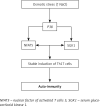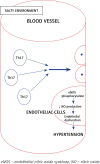High dietary salt intake activates inflammatory cascades via Th17 immune cells: impact on health and diseases
- PMID: 35316907
- PMCID: PMC8924833
- DOI: 10.5114/aoms.2020.96344
High dietary salt intake activates inflammatory cascades via Th17 immune cells: impact on health and diseases
Abstract
The incidence of immune-mediated inflammatory diseases (IMIDs) is on the rise. A high salt content in the diet was found to play a crucial role in mediating IMIDs. It was demonstrated that increased salt concentration favors the differentiation of CD4+ cells to pathogenic Th17 cells, which predispose to several inflammatory diseases by modulating the immunological milieu. In auto-immune diseases increased salt concentration causes stable induction of Th17 cells. In cancer, increased salt concentration triggers chronic inflammation and increases vascular endothelial growth factor levels. Salt-mediated proliferation of Th17 cells has been found to reduce nitric oxide production in the endothelial cells, leading to hypertension. Increased salt concentration was found to alter the intestinal flora, which favors local inflammation. This review attempts to explain the role of high salt concentration and its molecular pathways in causing IMIDs.
Keywords: Th17 cells; cancer; immunity; inflammation; sodium chloride.
Copyright: © 2020 Termedia & Banach.
Conflict of interest statement
The authors declare no conflict of interest.
Figures




Similar articles
-
High salt diet may promote progression of breast tumor through eliciting immune response.Int Immunopharmacol. 2020 Oct;87:106816. doi: 10.1016/j.intimp.2020.106816. Epub 2020 Jul 26. Int Immunopharmacol. 2020. PMID: 32721893
-
Sodium Chloride Aggravates Arthritis via Th17 Polarization.Yonsei Med J. 2019 Jan;60(1):88-97. doi: 10.3349/ymj.2019.60.1.88. Yonsei Med J. 2019. PMID: 30554495 Free PMC article.
-
Sodium chloride triggers Th17 mediated autoimmunity.J Neuroimmunol. 2019 Apr 15;329:9-13. doi: 10.1016/j.jneuroim.2018.06.016. Epub 2018 Jun 30. J Neuroimmunol. 2019. PMID: 29983198 Review.
-
Sodium chloride drives autoimmune disease by the induction of pathogenic TH17 cells.Nature. 2013 Apr 25;496(7446):518-22. doi: 10.1038/nature11868. Epub 2013 Mar 6. Nature. 2013. PMID: 23467095 Free PMC article.
-
Novel ideas about salt, blood pressure, and pregnancy.J Reprod Immunol. 2014 Mar;101-102:135-139. doi: 10.1016/j.jri.2013.04.001. Epub 2013 May 30. J Reprod Immunol. 2014. PMID: 23726817 Review.
Cited by
-
Hyponatremia in patients with arterial hypertension: pathophysiology and management.Arch Med Sci. 2023 Mar 26;19(6):1630-1645. doi: 10.5114/aoms/161578. eCollection 2023. Arch Med Sci. 2023. PMID: 38058704 Free PMC article.
-
Dietary anethole: a systematic review of its protective effects against metabolic syndrome.J Diabetes Metab Disord. 2023 Dec 27;23(1):619-631. doi: 10.1007/s40200-023-01322-1. eCollection 2024 Jun. J Diabetes Metab Disord. 2023. PMID: 38932801 Free PMC article.
-
Oxidative Stress Induced by High Salt Diet-Possible Implications for Development and Clinical Manifestation of Cutaneous Inflammation and Endothelial Dysfunction in Psoriasis vulgaris.Antioxidants (Basel). 2022 Jun 27;11(7):1269. doi: 10.3390/antiox11071269. Antioxidants (Basel). 2022. PMID: 35883760 Free PMC article. Review.
-
Association between ultra-processed food consumption and inflammation: insights from the STANISLAS cohort.Eur J Nutr. 2025 Feb 17;64(2):94. doi: 10.1007/s00394-025-03607-y. Eur J Nutr. 2025. PMID: 39960649
-
Salt Intake of Children and Adolescents: Influence of Socio-Environmental Factors and School Education.Nutrients. 2024 Feb 17;16(4):555. doi: 10.3390/nu16040555. Nutrients. 2024. PMID: 38398878 Free PMC article.
References
-
- Appel LJ. Reducing sodium intake to prevent stroke: time for action, not hesitation. Stroke. 2014;45:909–11. - PubMed
-
- Sugiura T, Takase H, Ohte N, Dohi Y. Dietary salt intake is a significant determinant of impaired kidney function in the general population. Kidney Blood Press Res. 2018;43:1245–54. - PubMed
-
- Strnad M. Salt and cancer. Acta Medica Croat Cas Hravatske Akad Med Znan. 2010;64:159–61. - PubMed
LinkOut - more resources
Full Text Sources
Research Materials
